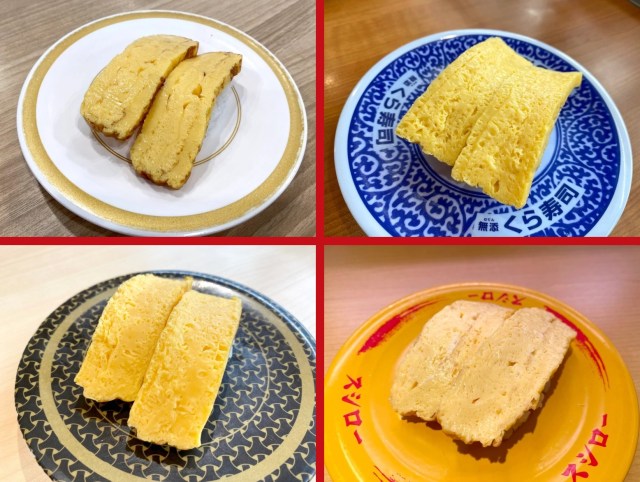
Looking for egg-celence at Japan’s big four kaitenzushi restaurants.
As foodies and linguists are quick to point out, “sushi” doesn’t mean “raw fish.” Instead, it refers to the vinegared rice.
That said, the vast majority of sushi is topped with raw fish, and it’s not at all unusual for the meals of sushi fans in Japan to be made up almost entirely of raw-fish sushi. An important exception, though, is tamago (egg) sushi. A strip of the Japanese-style omelet tamagoyaki placed atop a block of vinegared rice, tamago sushi is unique in that it’s a type of sushi that actually requires cooking, and so the specific chef and recipe can have a greater influence on the flavor than with other sushi toppings.
Because of this, our Japanese-language reporter P.K. Sanjun knew that tamago should be the next item on his continuing comparison of Japan’s big-four kaitenzushi/conveyor belt sushi restaurant chains, and he set off to perform his solemn duty of going out to eat a bunch of sushi.
▼ Clockwise from top left: Kappa Sushi, Kura Sushi, Sushiro, and Hama Sushi, all visited on the same day within three hours of each other
Because all four chains price their tamago sushi identically, at 110 yen (US$0.88) for two pieces, this taste test wouldn’t be a big hit to P.K.’s wallet. The effect might be more negative on his cholesterol level, but eight pieces of egg sushi in one day is a risk he’s willing to subject his body to for the sake of science.
● Kappa Sushi
“The egg for Kappa Sushi’s tamago sushi is the sweetest out of the four chains, but not overpoweringly so. The dashi stock the use is also really delicious, and I can’t find a single bad thing to say about it, and this is exactly what a lot of people imagine when they think of good, standard tamago sushi.”
● Kura Sushi
“The sweetness is much more subdued here, and the dashi doesn’t really make its presence felt all that much either. The result is that out of the four chains, Kura Sushi’s is the one where the natural flavor of the egg itself makes an impression. It’s still sweet enough that kids won’t complain about a lack of flavor, though.”
● Hama Sushi
“The level of sweetness here is somewhere between Kappa and Kura. In their marketing, Hama Sushi makes a point of talking up the dashi for this, but it didn’t feel uniquely strong to me. Overall, this is a nice, agreeably tasty egg sushi.”
● Sushiro
“On the other hand, Sushiro had the most noticeable dashi flavor out of all the restaurants. It’s the only one where the salty dashi notes are stronger than the sweet flavor. Maybe that’s because Sushiro started out in Osaka, and this is the Kansai region way of doing things? Still, it’s not a crazy-unusual flavor, and this will still hit the mark for people who are in the mood for tamago sushi.”
Just like P.K. had expected, the four chains’ egg sushi all had their own distinct tastes, from the sweet Hama, sweeter Kappa, simple Kura, and savory Sushiro, each tasty in its own special way. And if in addition to chicken eggs you’re also wondering which kaitenzushi chain’s salmon egg sushi is best for you, P.K. has you covered on that front too.
Photos © SoraNews24
● Want to hear about SoraNews24’s latest articles as soon as they’re published? Follow us on Facebook and Twitter!
[ Read in Japanese ]

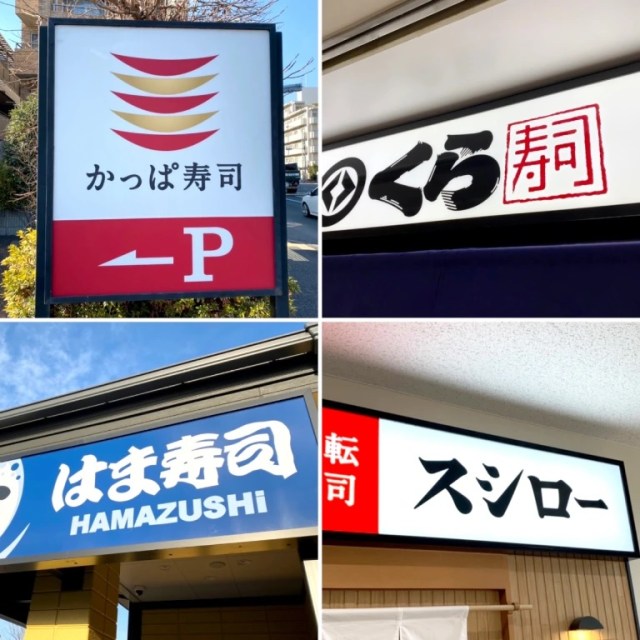
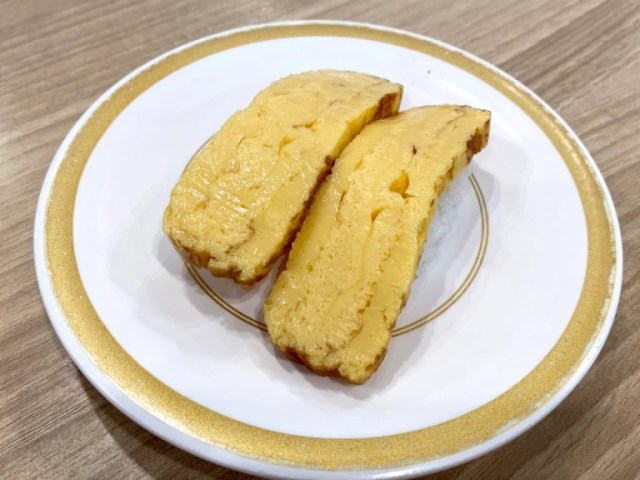
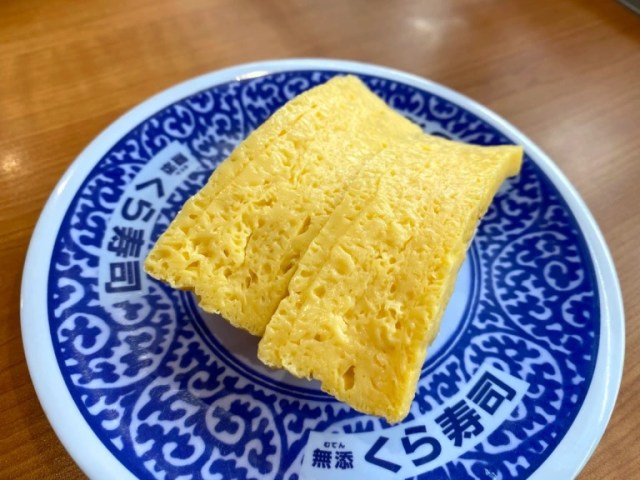
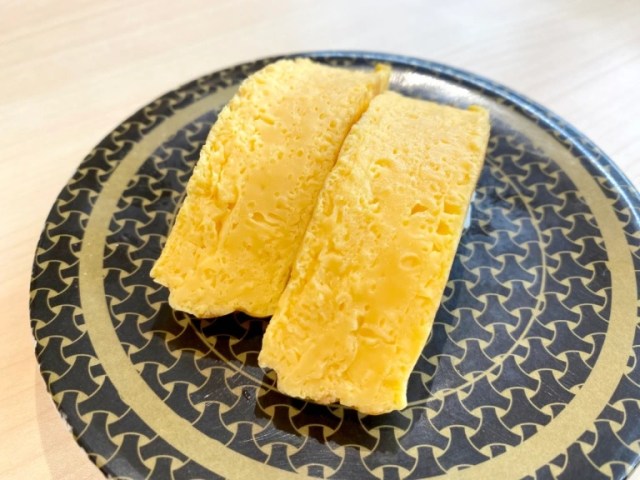

 Which Japanese conveyor belt sushi chain has the best squid sushi?【Taste test】
Which Japanese conveyor belt sushi chain has the best squid sushi?【Taste test】 Which Japanese conveyor belt sushi chain has the best negitoro sushi?【Taste test】
Which Japanese conveyor belt sushi chain has the best negitoro sushi?【Taste test】 Which Japanese conveyor belt sushi chain has the best scallop sushi?【Taste test】
Which Japanese conveyor belt sushi chain has the best scallop sushi?【Taste test】 Which Japanese conveyor belt sushi chain has the best aosa miso soup?【Taste test】
Which Japanese conveyor belt sushi chain has the best aosa miso soup?【Taste test】 Which Japanese conveyor belt sushi chain has the best salad sushi?【Taste test】
Which Japanese conveyor belt sushi chain has the best salad sushi?【Taste test】 Foreigner’s request for help in Tokyo makes us sad for the state of society
Foreigner’s request for help in Tokyo makes us sad for the state of society Japanese city loses residents’ personal data, which was on paper being transported on a windy day
Japanese city loses residents’ personal data, which was on paper being transported on a windy day Harajuku Station’s beautiful old wooden building is set to return, with a new complex around it
Harajuku Station’s beautiful old wooden building is set to return, with a new complex around it Red light district sushi restaurant in Tokyo shows us just how wrong we were about it
Red light district sushi restaurant in Tokyo shows us just how wrong we were about it Akihabara pop-up shop sells goods made by Japanese prison inmates
Akihabara pop-up shop sells goods made by Japanese prison inmates Sandwiches fit for a sumo served up in Osaka【Taste Test】
Sandwiches fit for a sumo served up in Osaka【Taste Test】 Historical figures get manga makeovers from artists of Spy x Family, My Hero Academia and more
Historical figures get manga makeovers from artists of Spy x Family, My Hero Academia and more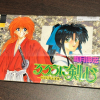 Creator of Rurouni Kenshin anime/manga admits to possession of child pornography
Creator of Rurouni Kenshin anime/manga admits to possession of child pornography Why Japanese doesn’t need swear words
Why Japanese doesn’t need swear words Harajuku Station will be demolished after the Tokyo Olympics and Paralympics
Harajuku Station will be demolished after the Tokyo Olympics and Paralympics McDonald’s new Happy Meals offer up cute and practical Sanrio lifestyle goods
McDonald’s new Happy Meals offer up cute and practical Sanrio lifestyle goods Japanese ramen restaurants under pressure from new yen banknotes
Japanese ramen restaurants under pressure from new yen banknotes French Fries Bread in Tokyo’s Shibuya becomes a hit on social media
French Fries Bread in Tokyo’s Shibuya becomes a hit on social media Studio Ghibli releases new action figures featuring Nausicaä of the Valley of the Wind characters
Studio Ghibli releases new action figures featuring Nausicaä of the Valley of the Wind characters New private rooms on Tokaido Shinkansen change the way we travel from Tokyo to Kyoto
New private rooms on Tokaido Shinkansen change the way we travel from Tokyo to Kyoto Tokyo Tsukiji fish market site to be redeveloped with 50,000-seat stadium, hotel, shopping center
Tokyo Tsukiji fish market site to be redeveloped with 50,000-seat stadium, hotel, shopping center All-you-can-drink Starbucks and amazing views part of Tokyo’s new 170 meter-high sky lounge
All-you-can-drink Starbucks and amazing views part of Tokyo’s new 170 meter-high sky lounge Beautiful Ghibli sealing wax kits let you create accessories and elegant letter decorations【Pics】
Beautiful Ghibli sealing wax kits let you create accessories and elegant letter decorations【Pics】 Studio Ghibli releases Kiki’s Delivery Service chocolate cake pouches in Japan
Studio Ghibli releases Kiki’s Delivery Service chocolate cake pouches in Japan New definition of “Japanese whiskey” goes into effect to prevent fakes from fooling overseas buyers
New definition of “Japanese whiskey” goes into effect to prevent fakes from fooling overseas buyers Our Japanese reporter visits Costco in the U.S., finds super American and very Japanese things
Our Japanese reporter visits Costco in the U.S., finds super American and very Japanese things Studio Ghibli unveils Mother’s Day gift set that captures the love in My Neighbour Totoro
Studio Ghibli unveils Mother’s Day gift set that captures the love in My Neighbour Totoro More foreign tourists than ever before in history visited Japan last month
More foreign tourists than ever before in history visited Japan last month New Pokémon cakes let you eat your way through Pikachu and all the Eevee evolutions
New Pokémon cakes let you eat your way through Pikachu and all the Eevee evolutions Sales of Japan’s most convenient train ticket/shopping payment cards suspended indefinitely
Sales of Japan’s most convenient train ticket/shopping payment cards suspended indefinitely Sold-out Studio Ghibli desktop humidifiers are back so Totoro can help you through the dry season
Sold-out Studio Ghibli desktop humidifiers are back so Totoro can help you through the dry season Japanese government to make first change to romanization spelling rules since the 1950s
Japanese government to make first change to romanization spelling rules since the 1950s Ghibli founders Toshio Suzuki and Hayao Miyazaki contribute to Japanese whisky Totoro label design
Ghibli founders Toshio Suzuki and Hayao Miyazaki contribute to Japanese whisky Totoro label design Doraemon found buried at sea as scene from 1993 anime becomes real life【Photos】
Doraemon found buried at sea as scene from 1993 anime becomes real life【Photos】 Tokyo’s most famous Starbucks is closed
Tokyo’s most famous Starbucks is closed One Piece characters’ nationalities revealed, but fans have mixed opinions
One Piece characters’ nationalities revealed, but fans have mixed opinions We asked a Uniqlo employee what four things we should buy and their suggestions didn’t disappoint
We asked a Uniqlo employee what four things we should buy and their suggestions didn’t disappoint Princesses, fruits, and blacksmiths: Study reveals the 30 most unusual family names in Japan
Princesses, fruits, and blacksmiths: Study reveals the 30 most unusual family names in Japan Which Japanese conveyor belt sushi chain has the best tuna sushi?【Taste test】
Which Japanese conveyor belt sushi chain has the best tuna sushi?【Taste test】 Which Japanese conveyor belt sushi chain has the best saltwater eel sushi?【Taste test】
Which Japanese conveyor belt sushi chain has the best saltwater eel sushi?【Taste test】 Which Japanese conveyor belt sushi chain has the best salmon sushi?【Taste test】
Which Japanese conveyor belt sushi chain has the best salmon sushi?【Taste test】 Which Japanese conveyor belt sushi chain has the best mackerel sushi?【Taste test】
Which Japanese conveyor belt sushi chain has the best mackerel sushi?【Taste test】 Which Japanese conveyor belt sushi chain has the best hamburger steak sushi?【Taste test】
Which Japanese conveyor belt sushi chain has the best hamburger steak sushi?【Taste test】 Which Japanese conveyor belt sushi chain has the best prawn sushi?【Taste test】
Which Japanese conveyor belt sushi chain has the best prawn sushi?【Taste test】 Which Japanese conveyor belt sushi chain has the best yellowtail sushi?【Taste test】
Which Japanese conveyor belt sushi chain has the best yellowtail sushi?【Taste test】 Which Japanese conveyor belt sushi chain has the best aburi salmon sushi?【Taste test】
Which Japanese conveyor belt sushi chain has the best aburi salmon sushi?【Taste test】 Which Japanese conveyor belt sushi chain has the best bintoro sushi?【Taste test】
Which Japanese conveyor belt sushi chain has the best bintoro sushi?【Taste test】 Which Japanese conveyor belt sushi chain has the best iwashi sardine sushi?【Taste test】
Which Japanese conveyor belt sushi chain has the best iwashi sardine sushi?【Taste test】 Which Japanese conveyer belt sushi chain has the best steamed egg custard? 【Taste test】
Which Japanese conveyer belt sushi chain has the best steamed egg custard? 【Taste test】 Which Japanese conveyor belt sushi chain has the best Prawn Tempura Sushi?【Taste test】
Which Japanese conveyor belt sushi chain has the best Prawn Tempura Sushi?【Taste test】 Which Japanese conveyer belt sushi chain has the tastiest sea snail, if any?【Taste test】
Which Japanese conveyer belt sushi chain has the tastiest sea snail, if any?【Taste test】 Which conveyor belt sushi place’s chawanmushi egg custard is the best? We investigate【Taste Test】
Which conveyor belt sushi place’s chawanmushi egg custard is the best? We investigate【Taste Test】 World’s largest Kura Sushi revolving sushi restaurant opens, but not in Japan【Video】
World’s largest Kura Sushi revolving sushi restaurant opens, but not in Japan【Video】 How to have a great meal at conveyer belt sushi chain Kura Sushi even if you hate raw fish
How to have a great meal at conveyer belt sushi chain Kura Sushi even if you hate raw fish
Leave a Reply